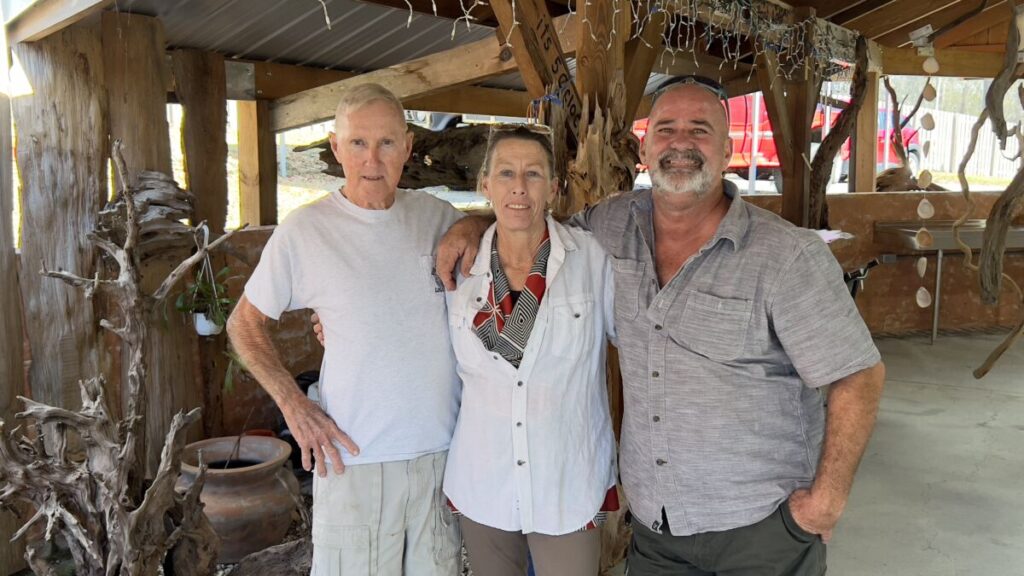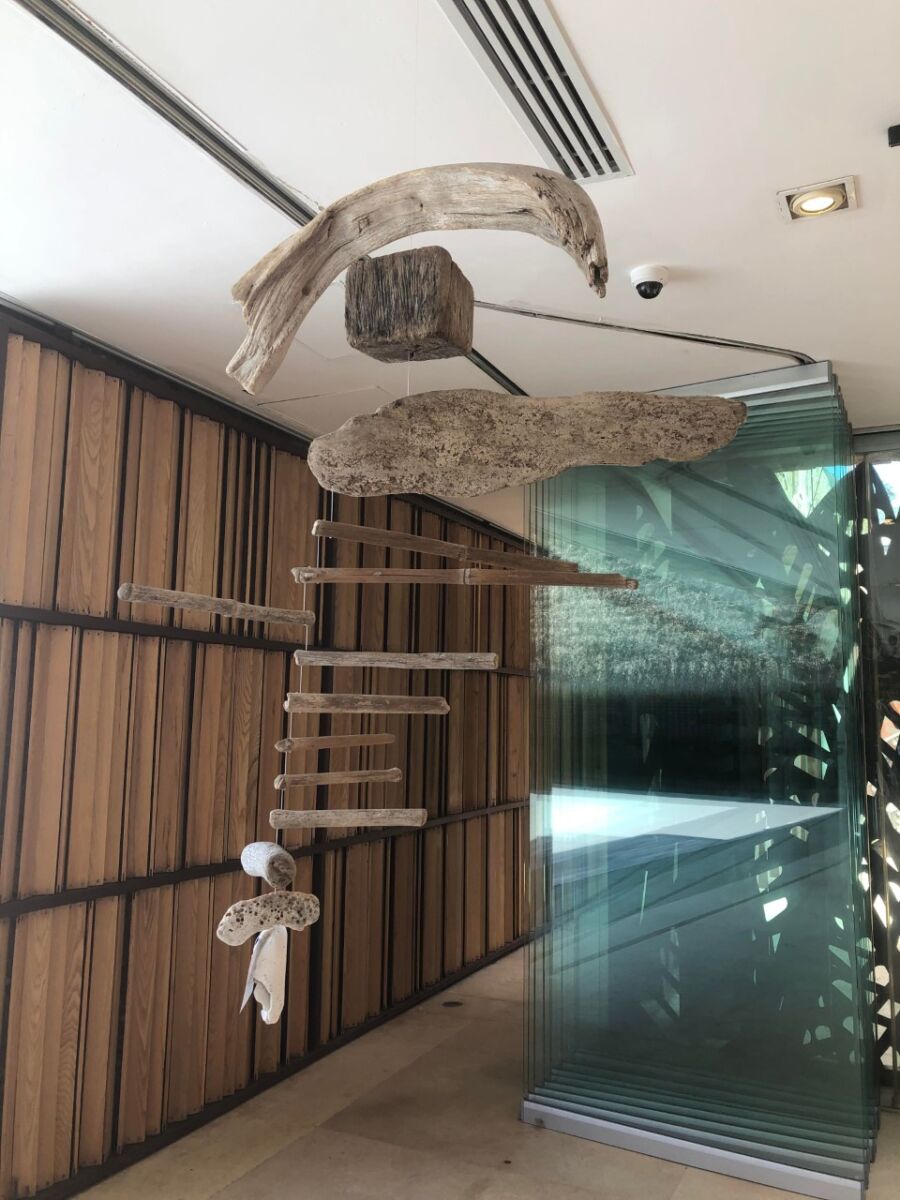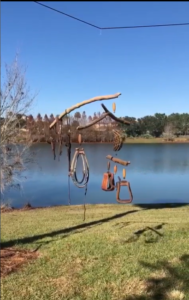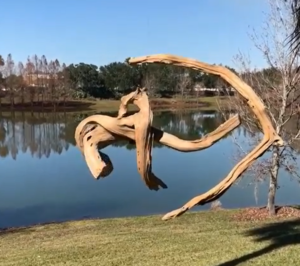Fabulous flotsam and jetsam
Organic designer Jane Maroni teams up with Ocala native and woodworker John Claytor to create hypnotic air sculptures from driftwood and other found objects.

Woodworking dream team: from left, John Claytor, has contributed his driftwood to artist Jane Maroni (center), who with the help of her husband, Chris Nielsen, creates air sculptures of found wood and other objects. [Julie Garisto]
Some artists exhibit technical skill and others distinguish themselves with a gift for recognizing and envisioning the transcendent in our everyday surroundings.
Artist Jane Maroni, owner of Jane Maroni Organic Design, belongs to the latter camp. She admits that she’s a terrible illustrator (“I can barely play hangman”), but her tactile and three-dimensional figural talents have manifested in the unique and eye-catching expressions of sculptural art.
Born and raised in Rhode Island, Maroni began her art career with glass and later began collecting driftwood, fishbones, coconuts, seeds and other natural objects she found on the beach during her daily walks.
Her one-of-a-kind pieces combine creative serendipity, engineering and design. Maroni’s mobile-like air sculptures, jewelry and even furniture take on a wholly unique raw, primitive and unique aesthetic of their own, and each piece, she said, represents a deep and personal expression of nature, balance, harmony and peace.
“Every single design is driven by emotions or mood of any given day or moment,” Maroni said.
An admirable facet of Maroni’s ethos, both personally and professionally driven, conveys through a refusal to accept the obsolescence of any abandoned or found object or living thing. She and her husband have rescued dogs in Mexico and she became an expert at organic gardening and pickling leftover food in Mason jars.

“Reflections”
15’H x 9’W
After spending a little more than a decade on the Mexican west coast, and some time in Hawaii before that, she and her husband, Chris Nielsen, relocated to the eastern U.S, eventually landing for the time being in north central Florida, where they met John Claytor at the Brownwood Farmers Market in Wildwood last December.
The stop for bric-a-brac, jams and cute stocking stuffers wasn’t the typical venue that Maroni sought to exhibit her primevally elegant air sculptures, but destiny seemed to have a hand in things when veteran woodworker and sculptor Claytor, owner of Dead Head Logging in Belleview, stopped to look at her art.
Claytor recently retired from submerged timber harvesting and now acts as an advisor for the trade. On seeing Maroni’s mobiles, he was mesmerized by the ethereal movement of the driftwood and objects bobbing and weaving in a gentle breeze.
“She had a few pieces hanging and I stood there and looked at them and I said, ‘This is cool stuff,’ he recalled of their meeting. “She asked me if I had any questions. I said, no, that I’d just like to look at it and take it in. I spent about 30 or 45 minutes there looking and noticed I’d been there a long time.”
Claytor, unbeknownst to him, had engaged in what Maroni calls “visual yoga,” a state of mind her air sculptures help facilitate in their viewers.
“Visual yoga is watching a piece dance while the viewer is either sitting or lying down, appreciating the physically calming and relaxing effects of every piece,” the sculptor explained.
“The sculptures seem to have a tranquilizing kind of effect,” she added, “the same way for a baby lying in a crib who starts crying. This is an adult version of that.”
Nielsen, Maroni’s husband of 33 years, is often a big help in constructing the pieces. She credits him as an engineer of her designs. Before they left Rhode Island, he was a commercial fisherman. She had an art gallery in Narragansett when they met.
Around 13 years ago, the couple arrived at a beach town north of Puerto Vallarta, where the beaches were “loaded with driftwood,” according to Nielsen.
Fast-forward to that fateful December 2022 day, when Claytor stood hypnotized by Maroni’s sculptures.

“Skipping Stones”
5’H x 3’W

“Wrangler”
Created from equestrian items and Claytor’s wood contributions.
She asked him again if there was anything she could answer.
“I said, ‘I think you need to come to my house and see what I do and what I have,’” Claytor responded.
It was jaw-dropping for Maroni to see Claytor’s compound filled with driftwood art and other wood masterpieces.
Some of it now co-stars in her creations.
“She has the insight,” Claytor said of his recent collaborator, underplaying his own skills and accomplishments in creating what he calls “stuff.”
Claytor has exhibited his designs in museums throughout Florida and across the U.S. His home estate and business are a sprawling wonderland of woodwork, including a gazebo that’s lovely enough to get married in.
He recovered his first underwater log in 1970 and had been a full-time deadhead logger before he retired from the wood-harvesting game and sold that portion of his business enterprises a year and a half ago.
In his younger years, Claytor manned a barge and retrieved sunken logs and timber that had already been cut, most of it more than 100 years ago.
The rarity, strength and beauty of the river wood makes it more valuable, he told the “Gazette’s” sister publication, “Ocala Style” magazine, in a 2016 interview, adding that much time, effort and money goes into getting it.

“Painted Desert”
Incorporates driftwood from Claytor’s collection
The lifelong Floridian doesn’t use the word “art” lightly and defers to Maroni as the artist of their collaboration.
“My stuff was in the Peter Powell Roberts Museum in Avon Park for seven years,” he said, “but I’ve done stuff all over the country and Florida—the Smithsonian, you name it—created from what I’ve found underwater.”
One of Claytor’s collaborations with Maroni, an air sculpture titled “Painted Desert,” features two pieces of wood that were submerged for years off the Florida coast, until he harvested them.
“I personally like the simplicity of two bold pieces united to create one,” Maroni said of the sculpture. “Our mobiles are intended for indoors; and while this piece appears to be heavy, it is actually quite light in weight.”
“The Wrangler,” an homage to the artist’s time in Ocala’s horse country, includes rider accoutrements. Maroni found most of its wood in Oregon, but some wood beads and pieces come from Claytor’s collection.
“This piece was a challenge because it took three months to get my hands on this old tackle,” she wrote on the photo’s Instagram caption, adding a thanks to Claytor’s wife, Cathy, and a shout-out to everyone who helped her with the riding gear.
For more information about Maroni’s installations, visit janemaroniorganicdesigns.com. For information about Claytor’s wood sculptures, go to facebook.com/ DeadHeadLogging.





